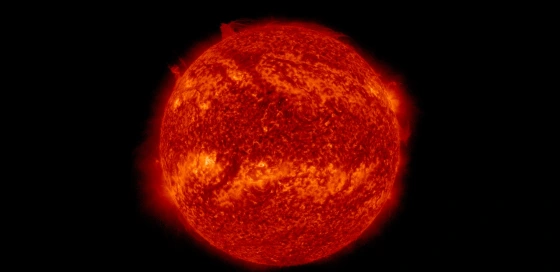Top Stories
NASA Observatory Records Unusual Activity On The Sun
NASA Observatory Records Unusual Activity On The Sun

Space is very big and quite often, very weird. Last week, an image captured by NASA‘s Reconnaissance Orbiter looked just like a bear, and “The Green Comet” reached its closest point to Earth in 50,000 years. This week we’ve got a whole new set of developments. Here’s what you may have missed.
Testing, 1, 2, 3
Starting off, this week saw some big tests for the future of spaceflight. After what’s become an almost routine Falcon 9 satellite launch on Tuesday, SpaceX fired up all but two stages of the 33-stage booster rocket Thursday meant for its long-awaited Starship spacecraft in Texas. If all continues to go well, SpaceX says the first Starship launch could happen as early as March.
Over in Hancock County, Miss., NASA conducted tests of a new rocket engine it hopes will power future flights to the moon, and at the Satish Dhawan Space Centre in Sriharikota, India, the Indian Space Research Organisation (ISRO) succeeded in launching its Small Satellite Launch Vehicle (SSLV) into orbit.
The sun is acting a little sus
Footage of a “massive polar vortex” recorded by NASA’s Solar Dynamics Observatory on Feb. 2, went viral this week, and scientists aren’t exactly sure what’s going on.
The vortex formed after a giant plasma filament located at 55 degrees latitude broke off from the sun’s surface. While this is the first time we’ve observed anything quite like this, the National Center for Atmospheric Research says increased solar activity at that particular location is a common feature of the 11-year solar cycle, during which the sun builds up to “solar maximum,” flips its polarity, then resets to “solar minimum.” However, the scientific community doesn’t know why it happens or how it affects the reversal of the sun’s magnetic field. The sun is projected to reach its next solar maximum in 2024, so it’s entirely possible we’ll see more strange solar phenomena between now and then.
Meet our newest neighbor
Astronomers discovered a potentially habitable exoplanet orbiting a star in the Cygnus constellation, 31.2 light-years away. The planet, Wolf 1069b, is just a little larger and about 25% heavier than Earth and appears to have a rocky surface. Its presence in the so-called “habitable zone” of its solar system — not too hot and not too cold — suggests that there could also be liquid water on its surface, and an atmosphere.
But that’s where Wolf 1069b’s similarities to Earth end. Wolf 1069b is tidally locked to its sun, so one side of the planet is always day, and the other half is always night. It’s also much closer to its host star, a red dwarf, which is much smaller and much cooler than our own. Without an atmosphere, the surface temperature is estimated to swing between 55 degrees on the bright side and a frigid minus 140 degrees on the dark side. However, if Wolf 1069b does indeed have an atmosphere to trap in heat, the average surface temperature could sit at around 40 degrees. Still, the evidence to suggest that Wolf 1069b could sustain life is there, even if it may not be a great place to visit.
The mysterious case of Quaoar’s ring
Finally, this week brought to light the puzzling discovery of a ring around Quaoar, a dwarf planet about half the size of Pluto sitting in the Kuiper Belt beyond Neptune. Rings usually form when objects enter orbit around a celestial body within what’s known as the Roche limit, the distance within which gravitational forces cause objects to disintegrate. However, Quaoar’s ring appears to orbit outside that limit, at a distance where orbiting objects should clump together to form a moon. So how did Quaoar’s ring form? The short answer is: Nobody knows.


 News23 hours ago
News23 hours agoNIGERIAN BREWERIES PARTNERS OZA CARNIVAL

 Top Stories11 hours ago
Top Stories11 hours agoTinubu’s Aide Condemns Plan To Reinstall ‘Jesus Is Not God’ Banner In Lekki Mosque

 Top Stories6 hours ago
Top Stories6 hours agoBreaking: FIRS Announces Fresh Recruitment, See Eligibility Criteria, Application Deadline

 News11 hours ago
News11 hours agoPetrol To Sell ₦935/Litre From Today – IPMAN

 Top Stories11 hours ago
Top Stories11 hours ago2025 Budget Cannot Address Nigeria’s Economic Challenges – Atiku

 Entertainment11 hours ago
Entertainment11 hours agoI will be more influential in Nigeria than UK – Tobi Adegboyega

 News11 hours ago
News11 hours agoPresident Tinubu’s reforms not responsible for food stampedes – FG

 Top Stories8 hours ago
Top Stories8 hours agoPrimate Ayodele’s Prophecies For 2025







